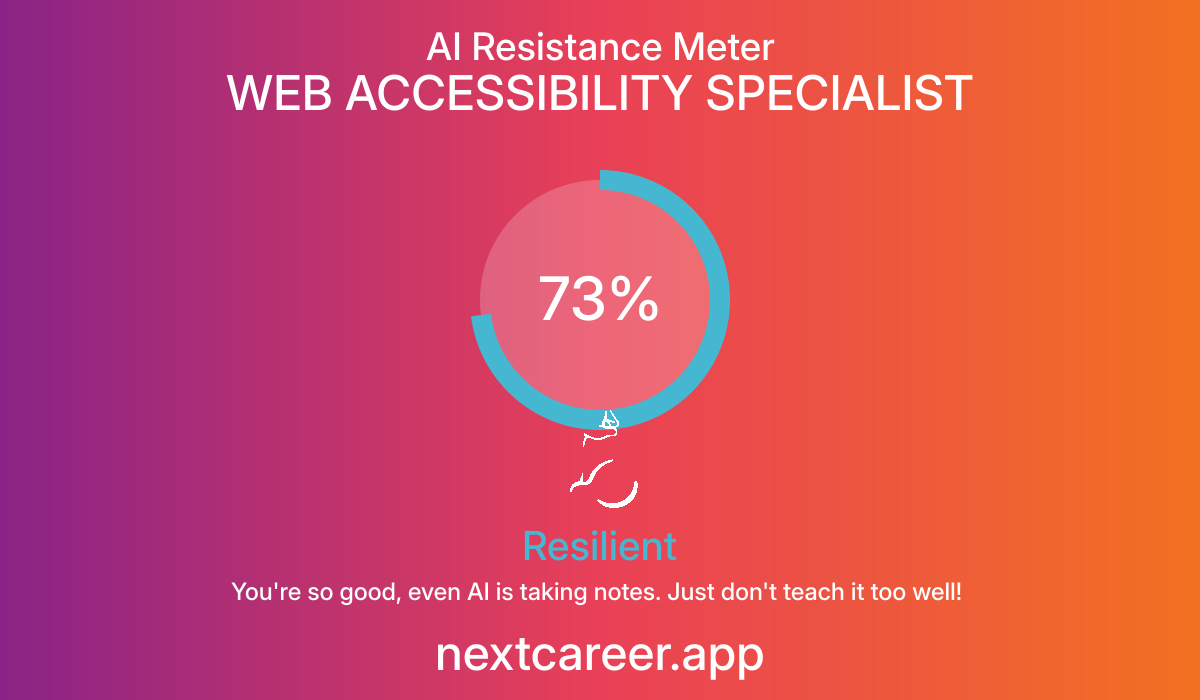AI Resistance Analysis
WEB ACCESSIBILITY SPECIALIST
WEB ACCESSIBILITY SPECIALIST
AI Resistance Score
AI Resistance Meter
Resilient
WEB ACCESSIBILITY SPECIALIST
You're so good, even AI is taking notes. Just don't teach it too well!
The role of a Web Accessibility Specialist focuses on ensuring that websites and digital content are accessible to all users, including those with disabilities. While some aspects of this role can be supplemented by AI, particularly in testing and compliance checks, the nuanced understanding of user experience and critical thinking required to adapt web solutions to diverse needs will maintain the importance of human specialists in this field.
The role of a Web Accessibility Specialist focuses on ensuring that websites and digital content are accessible to all users, including those with disabilities. While some aspects of this role can be supplemented by AI, particularly in testing and compliance checks, the nuanced understanding of user experience and critical thinking required to adapt web solutions to diverse needs will maintain the importance of human specialists in this field.
Key Factors
- Cognitive Tasks: The role involves evaluating web content for accessibility, which can be partially automated but requires human insight for context and user experience.
- Emotional Intelligence: Understanding user needs, particularly for diverse and underserved communities, involves empathy and emotional intelligence that AI currently lacks.
- Physical Skills: The position does not require physical labor but involves often collaborating with developers and designers to implement changes.
- Creative Thinking: Innovating solutions for accessibility challenges and crafting user experiences demands creativity that AI cannot fully replicate.
Human Advantages
- Deep understanding of human behavior and diverse needs.
- Ability to empathize with and advocate for users with disabilities.
- Creative problem-solving skills for unique accessibility challenges.
AI Vulnerabilities
- Automated testing tools may replace manual compliance checks.
- Basic accessibility issues may be detected by AI, reducing the need for basic evaluations.
Recommended Actions
- Enhance training in user experience design and empathy to better understand user needs.
- Advocate for the integration of AI tools in accessibility practices while maintaining a human oversight role.
- Stay updated with emerging technologies in AI to leverage them for better efficiencies in work processes.
- Engage in continuous learning about disabilities and accessibility technologies to remain an indispensable resource in the field.
In the near term, expect AI to enhance existing workflows by automating routine compliance checks. Over the long term, roles may evolve to focus more on strategic advocacy and user experience design, with specialists likely taking on a consultancy role for AI systems to ensure they respect accessibility principles. A potential shift may also occur where the collaboration between AI tools and human specialists creates a more seamless process for developing accessible web solutions.

Why Calculate AI Resistance?
Understanding how AI-resistant your career is becoming increasingly important in today's rapidly evolving job market. Our analysis combines multiple factors including required human skills, technological adaptability, and future industry projections to give you a comprehensive view of your career's sustainability.